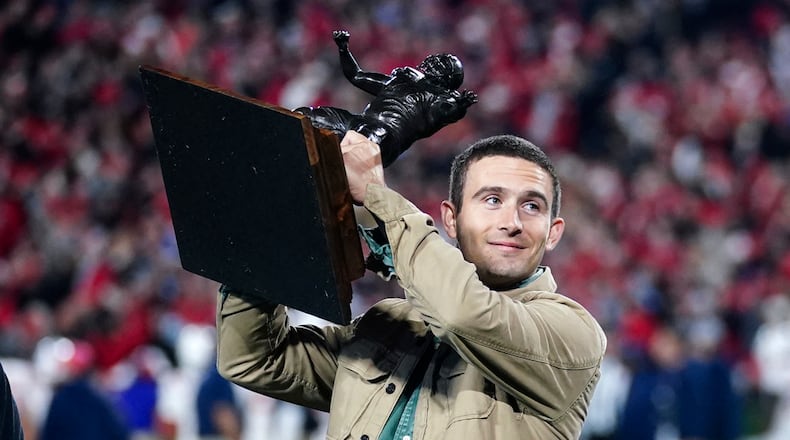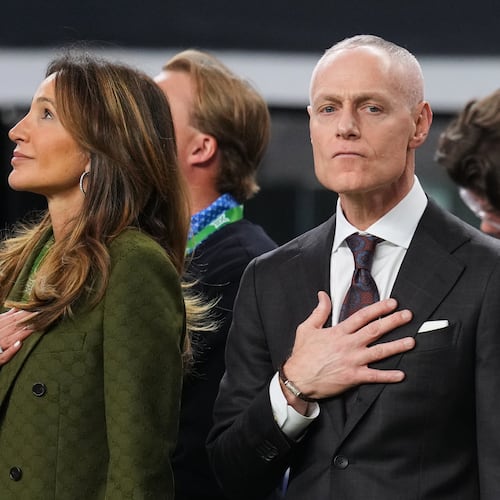MIRAMAR BEACH, Florida – Georgia football coach Kirby Smart and basketball coach Mike White left the SEC Spring Meetings Wednesday afternoon without comment. Both cited having a plane to catch at a nearby Destin airfield.
Regardless, there wasn’t a lot to report on Day 2 of the league’s annual end-of-year conference here at the Hilton Sandestin Beach Resort. That doesn’t mean there wasn’t a lot to talk about.
Football coaches, basketball coaches, athletic directors and presidents and chancellors debated for hours Wednesday the many complicated issues pervading college athletics at the moment. However, little if anything has been resolved here.
“A bunch of questions going in,” Tennessee coach Josh Heupel said of this week’s proceedings. “Probably more coming out.”
Following is some of the subjects that were being discussed Wednesday:
Roster sizes
By far, the threat of scholarship reductions because of the House vs. NCAA settlement is the most prominent concern of SEC coaches. As programs seek to get costs under control under the threat of the multibillion-dollar judgment, the question has been raised as to whether Division I football truly needs 85 scholarships.
“The number one thing is just roster sizes and management as we move forward,” Heupel said. “But there’s no consensus on anything right now. Obviously, our presidents and athletic directors are working to find us a good landing spot.”
NFL teams obviously operate with much smaller, 53-man rosters, though they have unlimited access to more players via free agency and field small practice squads.
The SEC brought in Dr. Allen Sills, the NFL’s chief medical officer, to talk to SEC football coaches about how to safely manage a smaller number of athletes over what could be a longer season.
However, any actual changes in roster sizes likely would have to be adopted on a national level. So, there will be no actions taken by the SEC this week.
“That’s a discussion right now, not a decision,” commissioner Greg Sankey said.
Eliminating walk-ons
Eliminating walk-ons is part of the discussion as college athletics transitions to what many believe will be a true revenue-sharing model. “If” and “when” are still being debated, but it’s a genuine consideration.
Why? Georgia athletic director Josh Brooks attempted to explain.
“At the simplest level, what we’re going to see is a world where there’s going to be no scholarship limits,” Brooks said Wednesday afternoon. “So they’re going to come in and look at national limits on roster limits per sports. That’s what’s going to drive a lot of this. And, again, this isn’t the SEC making a decision in a vacuum. This is going to be several groups coming together to make this decision.”
Not surprisingly, coaches are not advocates.
“To a man, I don’t think anybody wants that to happen,” Arkansas coach Sam Pittman said. “I’m not saying it’s going to, but the first thing that came to my mind when we started talking about numbers was Burlsworth. Think about all the great players that earned his award, including himself. There’s an award because of his great story. So, we’d hate to lose that and we all voiced that opinion.”
Brandon Burlsworth walked on at Arkansas in 1994 and became an All-American as an offensive lineman. He was killed in a car accident shortly after being selected in the 1999 NFL Draft. The Burlsworth Trophy was named in his honor in 2010 and since then has been presented annually to a player deemed the nation’s top former walk-on.
Former Georgia quarterback Stetson Bennett won the Burlsworth after leading the Bulldogs to the national championship in 2022 and probably should have won it in 2021 as well.
“I don’t know anybody who wouldn’t defend walk-ons,” Smart said Tuesday. “We’re talking about something that just makes sense. Now, when you implement that known fact into some form of settlement that I don’t completely understand, I don’t know where that factors in. But when you look at Dabo Swinney’s career, Will Muschamp’s career, you look at Ladd McConkey, you look at guys that have come to schools and then gone on to be successful football players, successful football coaches, successful at everything they do, they overcame the ultimate odds, I don’t know anybody who would be against having those walk-ons.”
Availability reports
One change that might be closer to becoming a reality are “availability reports.” Basically, they’re injury reports, but the SEC doesn’t like using that terminology.
Because of HIPAA (Health Insurance Portability and Accountability Act) laws that protect an individual’s medical information, indications are that teams would be deliberately vague about the reason an athlete might be unavailable, but must publicly declare availability at a designated time ahead of an intraconference competition.
The aim is to eliminate the opportunity for malfeasance and interference from the ever-growing gambling industry and community.
“If it helps with gambling, then I’m all for it,” Smart said. “If it’s geared for getting knowledge out there that people are trying to get from our student-athletes and it protects them, I’m certainly for that. … The NFL model obviously works for them. I don’t know what all this entails for us.”
Heupel said the concept was only briefly discussed by the football coaches and nothing was finalized as roster limits dominated their meeting.
It’s unlikely the practice will be formalized this week.
“It’s a cultural change for us, but things are changing around us,” Sankey said. “This is intended to be the beginning of a discussion, not a decision point. That’s how I frame it.”
Continued expansion
With both the ACC and Big Ten set for the moment with 18 teams, the question about whether the SEC would be satisfied to stay at 16 has come up. Meanwhile, first Florida State and now Clemson have expressed displeasure with their current arrangement the ACC. Naturally, it has been speculated they might like to come the SEC’s way.
Sankey won’t say anything definitive on the subject of continued expansion. He prefers to joke about it.
“The pinwheel’s getting really tight,” Sankey quipped, referring to the league’s new 16-team emblem. “We’re down to 8-point font on the big logo. I don’t know if we can go down to 6.5.”
Joking aside, Sankey definitely hasn’t slammed the door shut on the SEC growing even larger.
“I’m aware of what’s happening around us,” Sankey said. “We’re in a really, really great position as a league. Our focus has been on our 16. But I pay attention.”
The SEC added two teams in 1992 (Arkansas and South Carolina), two teams in 2012 (Missouri and Texas A&M) and two teams this year (Oklahoma and Texas). In the past – and even this week – Sankey has said the league prefers flagship state universities. Neither FSU or Clemson meet that requirement. North Carolina and Virginia do, however.
Stay tuned.
Settlement status
Four different times during his news conference late Tuesday, Sankey offered the clarification, “the settlement’s not done,” when he was asked about it. It clearly has been an initiative this week for the commissioner to emphasize that the settlement has not been legally finalized.
“There is a process to play out,” Sankey said. “Instead of Nick Saban being up here talking about ‘the process,’ I’m the one up here talking about the process. It will play out over months.”
Sankey said it “could be next year” before all the legal ramifications are negotiated.
Last week the NCAA and the Power 5 conferences agreed to settle the House vs. NCAA case and two similar lawsuits. The initial ruling was that the NCAA and those conferences pay $2.8 billion to current and former athletes (going back to 2016) over the next 10 years for lost potential NIL (name, image and likeness) revenue. The secondary issue being worked out is to directly pay college athletes.
While the details of that still have to be worked, athletic directors have to move forward on planning their budgets for 2025 and beyond. They’re having to account for what could be an expense of $20 million or more a year.
Brooks was asked how Georgia is proceeding.
“We’re just using the $20 million just as a good round number, but we know there’s going to be some fluctuations,” Brooks said between AD meetings Wednesday. “… We think 20 is a good starting point.”
About the Author
Keep Reading
The Latest
Featured



